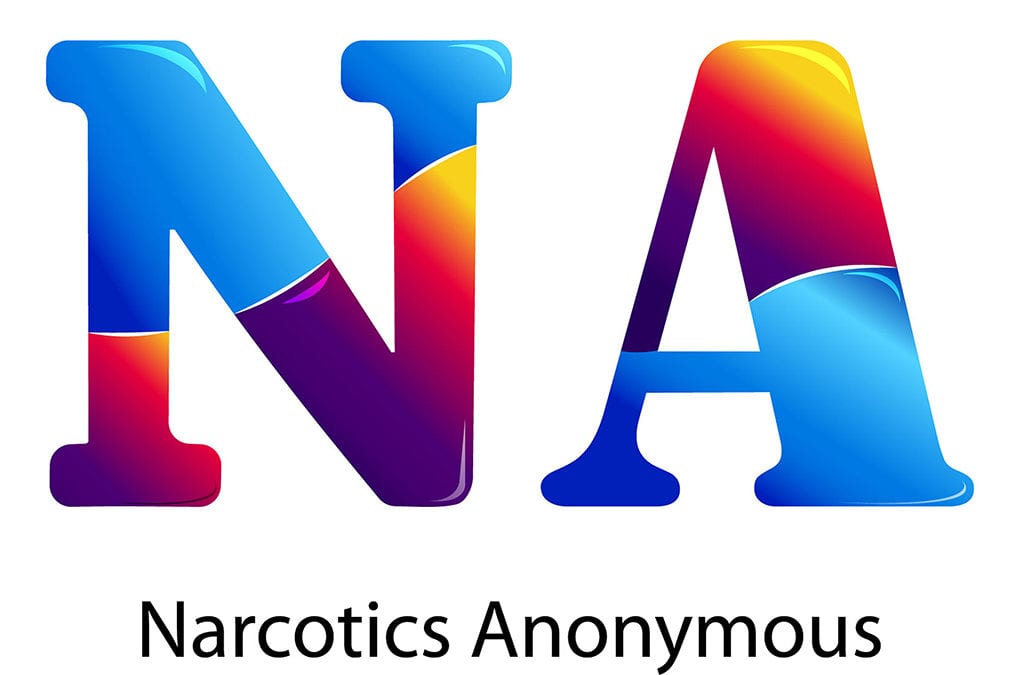Skip Ahead to Topic
Understanding Narcotics Anonymous
Narcotics Anonymous (NA) is a popular nonprofit fellowship program for men and women struggling with drug addiction. The Narcotics Anonymous (NA) 12-step program is internationally recognized as one of the most highly successful models for addiction recovery. Inspired by the success of Alcoholics Anonymous (AA) and begun by recovering drug addicts in California in 1953, this program has expanded to roughly 70,000 weekly meetings in over 130 countries. To date, NA is the second largest 12-step organization.
As with other 12 step programs, the goal of Narcotics Anonymous is to create a recovery community for those with substance abuse problems. In sharing their struggles and triumphs in the battle against their addictions, members of NA find the strength to keep fighting the good fight for a better, healthier, drug-free life.

The History of Narcotics Anonymous
The idea for Narcotics Anonymous dates back to 1944, when AA’s co-founder Bill Wilson was considering a separate fellowship for individuals suffering specifically from drug abuse. In 1947, a group devoted to recovering drug addicts called NARCO was founded. Group members met each week at the U.S. Public Service’s treatment center in Lexington, Kentucky’s federal prison. A member of the original NARCO group carried the idea of a fellowship for drug addicts to the New York Prison system in 1948, but the program there was short-lived and didn’t follow the 12 steps and traditions.
NA was formally established in 1953. At that time, Jimmy Kinnon and a group of other recovering drug addicts who were also former AA members petitioned Alcoholics Anonymous for use of its 12-step model and traditions. AA granted permission for them to do so but required that they choose a different name for their program. And so, Narcotics Anonymous was born.
Written in 1962 and published in 1996, the “Little White Book” marked the first official publication for Narcotics Anonymous. The booklet contained the 12 steps, the personal stories of some addicts, and a few other documents that would later become part of what is now NA’s Basic Text, its version of the AA’s Big Book.
There were some rocky moments in the early years of Narcotics Anonymous. For starters, NA did not enjoy the same kind of national support that AA did. Groups struggled to find places to meet, in part because an old law prohibited convicted felons from congregating. In some cases, groups were able to meet illicitly in church basements; at other times, they had to resort to gathering in members’ homes. Many NA groups were also not adhering closely to the 12 traditions in the early years. Some of the groups were accepting money from businesses and individuals outside of the association, compromising the organization’s integrity. For this and other reasons, meetings began to decline. In 1959, there was actually a four-month period during which no meetings at all were held. That low spurred Kinnon and others in NA leadership to attempt to restart NA, with the resolve that all traditions would be strictly upheld.
It was during the 1970s when NA saw the most growth. There were just 20 regular meetings across the United States in 1970, but in just two years that number shot up to 70 meetings. The organization also breached the international barrier during this period, with meetings starting up in Australia, Bermuda, and Germany. By 1976, there were about 200 registered groups, and by 1983, as many as 2,966 meetings in over a dozen countries. NA has continued to grow ever since.

How Does the Narcotics Anonymous (NA) 12-Step Program Work?
The goal of NA is to help drug addicts get from a place of hopelessness and helplessness to a place of empowerment and strength, where they are able to abstain from the substances that control them. Like AA, the program is free and emphasizes abstinence from the addicting substance, personal growth, and reliance upon a High Power.
Recovery is made possible through working the 12 Steps, through conforming to the program traditions, and through the fellowship NA groups provide.
The NA 12 Steps
The NA 12 Steps guide individuals through a recovery process that involves taking a personal inventory of flaws and failings, grabbing hold of faith, making amends for wrongs done, and serving others.
- We admitted that we were powerless over our addiction; that our lives had become unmanageable.
- We came to believe that a Power greater than ourselves could restore us to sanity.
- We made a decision to turn our will and our lives over to the care of God as we understood Him.
- We made a searching and fearless moral inventory of ourselves.
- We admitted to God, to ourselves, and to another human being the exact nature of our wrongs.
- We were entirely ready to have God remove all these defects of character.
- We humbly asked Him to remove our shortcomings.
- We made a list of all persons we had harmed, and became willing to make amends to them all.
- We made direct amends to such people wherever possible, except when to do so would injure them or others.
- We continued to take personal inventory and when we were wrong promptly admitted it.
- We sought through prayer and meditation to improve our conscious contact with God as we understood Him, praying only for knowledge of His will for us and the power to carry that out.
- Having had a spiritual awakening as the result of these steps, we tried to carry this message to addicts, and to practice these principles in all our affairs.
Because of the belief that recovery happens best in community, the Steps use the first-person, plural pronoun: we. The purpose of that pronoun is also to emphasize that personal responsibility is key to recovery: addicts must break the cycle of denial that often accompanies addiction. Members often recite these steps together in their weekly meetings, reminding themselves that they are responsible for their recoveries and at the same time, hearing the voices around them, that they are not alone.
Another key component of the 12 steps is learning to trust a higher power. NA is not affiliated with any particular religion, but like AA, it is a distinctly “spiritual” program. The NA 12 Steps encourage members to formulate their own understanding of this Higher Power upon whom they must rely for guidance and strength, if a formal faith does not already provide that for them.
Individuals work through the 12 Steps along with others, including a mentor. A sponsor is essentially a recovery mentor, who has maintained sobriety for a significant amount of time by actively following the 12 Steps. Generally, NA sponsors are of the same gender as those they are mentoring.

The 12 Traditions of NA
Just as the 12 Steps are guidelines for recovery for the individual, the 12 Traditions are guidelines to protect the NA group and help it thrive. Narcotics Anonymous believes that adhering to the 12 Traditions as a group helps to create the best possible environment for members to work through those 12 Steps to recovery.
The 12 Traditions are as follows:
- Our common welfare should come first; personal recovery depends on NA unity.
- For our group purpose there is but one ultimate authority – a loving God as He may express Himself in our group conscience. Our leaders are but trusted servants; they do not govern.
- The only requirement for membership is a desire to stop using.
- Each group should be autonomous except in matters affecting other groups or NA as a whole.
- Each group has but one primary purpose – to carry the message to the addict who still suffers.
- An NA group ought never endorse, finance, or lend the NA name to any related facility or outside enterprise, lest problems of money, property, or prestige divert us from our primary purpose.
- Every NA group ought to be fully self-supporting, declining outside contributions.
- Narcotics Anonymous should remain forever nonprofessional, but our service centers may employ special workers.
- NA, as such, ought never be organized, but we may create service boards or committees directly responsible to those they serve.
- Narcotics Anonymous has no opinion on outside issues; hence the NA name ought never be drawn into public controversy.
- Our public relations policy is based on attraction rather than promotion; we need always maintain personal anonymity at the level of press, radio, and films.
- Anonymity is the spiritual foundation of all our Traditions, ever reminding us to place principles before personalities.
What to Expect at Meetings
Finding an NA meeting near you is as simple as going to https://www.na.org/meetingsearch/ and searching for a meeting in your state. Austin area meeting locations, dates, and times may also be accessed on the Central Texas Area Narcotics Anonymous website (http://ctana.org). Meetings take place in a variety of places, including churches, community centers, hospitals, and even parks.
Meetings typically follow one of two formats: speaker meetings or open discussions. At a speaker meeting, one individual shares his or her personal story for most of the length of the meeting time. As you probably guessed, open discussions allow anyone who wants to share to do so. Members are asked to only share about their personal experiences, however, and not to comment on the experiences or comments of others in the group. Members are also encouraged to be conscious of the length of time they speak, so that others who wish to contribute have time to do so.
As a newcomer, you’ll notice that members only introduce themselves by their first names: this is the “anonymous” part of Narcotics Anonymous. You’ll also notice that groups members identify themselves as “addicts” as part of their introduction: “Hi, I’m Matt, and I’m an addict”. There are few rules in NA meetings, aside from the request that those present listen respectively to whomever is speaking (stay off that cell phone if you can!) and that attendees not bring any drugs or drug paraphernalia into the meetings.
Do you have more questions about NA meetings?
Click here for more information on what to expect at an NA meeting. You may also find NA.org’s An Introduction to NA Meetings to be helpful reading.
Want to familiarize yourself with NA Literature in advance of your first meeting?
Click here.
So, Does NA Work?
The first studies on recovery outcomes of NA for its members took place during the 1990s in London, England. This initial study found there to be a positive relationship between the duration of group membership and a subject’s abstinence. It also showed increased self-esteem and reduced anxiety. Other studies since have upheld the effectiveness of NA and other 12-Step programs in helping people who suffer from the disease of addiction recover their lives and self-respect. As with many behavioral health studies, more research is needed, however. Experts have rightfully pointed out an information gap for certain ethnic groups, as well as for outpatient addicts generally. Traditionally, most of the work has been focused on Caucasian recovering addicts in inpatient settings. That caveat aside, the current results from the program are highly promising.
Of course, most people in search of recovery help can’t be bothered to read study literature. It’s the anecdotal evidence that is often most compelling: the stories of people they know who have found in NA and its 12 steps and traditions the truths and fellowship they needed to break the bonds of their addictions. Treatment centers and therapists are important parts of recovery, but so too is the fellowship of other wounded soldiers willing to fight and march alongside you down the road to wholeness.
Narcotics Anonymous and its members understand a pivotal truth about addiction: there’s more to recovery than quitting the drugs. As the NA’s Basic Text reminds us, “Our disease involved much more than just using drugs, so our recovery must involve much more than simple abstinence.”


Recent Comments